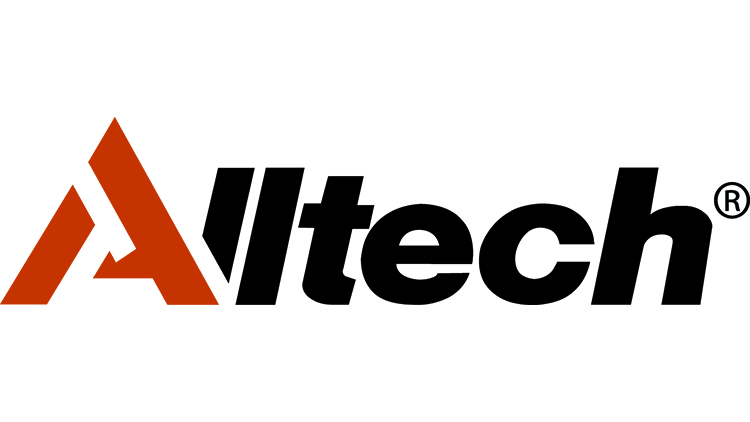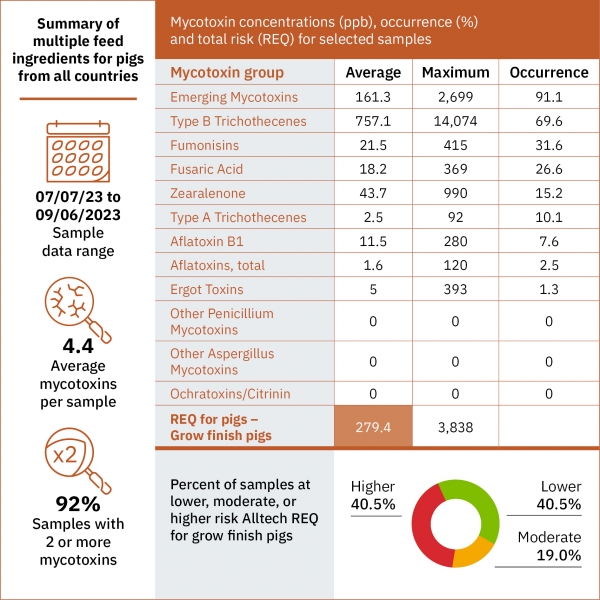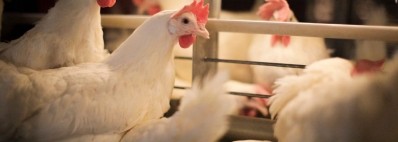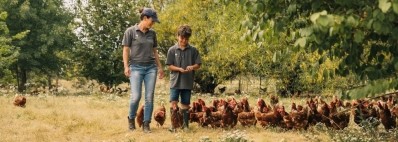Promotional Features
The mycotoxin landscape: Insights on the impacts of climate variability on mycotoxin risk
As the agricultural industry navigates the complexities of the ever-changing climate, the impact on crop quality and mycotoxin presence remains a subject of close examination.
A comparison of the 2022 and 2023 growing seasons in North America and Europe reveals a dynamic landscape with varying conditions and potential consequences for the feed and livestock industry.
The Alltech Harvest Analysis, a decade-long initiative, is a comprehensive step in understanding the complexities of new crop quality and mycotoxin prevalence. The program captures trends and enables robust data comparisons across years and regions. This analysis plays a pivotal role in empowering feed and livestock producers with the knowledge they need to make informed decisions.
With collaborators like SGS, Stratford Ontario and Masterfeeds, the program boasts a diverse pool of internal and external data sources, ensuring a representative snapshot of the global grain trade. This connection extends benefits to feed and livestock producers in regions like Asia, where the quality of imported grains significantly influences overall production.
Contrasting conditions in Europe: A closer look
In Europe, the stark contrast between the 2022 and 2023 growing seasons has been particularly evident. A drought-stricken 2022 was followed by a wetter climate in 2023, further divided between northern and southern regions. To navigate these fluctuating conditions effectively, innovative tools and services like CropProphet are extremely beneficial. CropProphet is a weather-driven grain yield forecasting system designed to help global agriculture industry participants with an interest in grain quality and yield.
Southern Europe, encompassing regions like Spain and Greece, has experienced an extended period of above-normal rainfall in August and September, following an early season drought that affected winter crops in Spain from January to May. This raises concerns about an upswing in Fusarium mold and mycotoxin production within corn crops in these areas. Meanwhile, Northern Europe, including Scandinavia and the Baltic states, also witnessed a surplus of moisture leading to a delayed harvest and more opportunities for mold development.
Central and Western Europe, on the other hand, have largely maintained normal or slightly above-normal precipitation levels. However, this seemingly favourable condition may not be without its challenges. In Denmark, for example, higher precipitation levels are leading to mycotoxin concerns as late-season rainfall intersects with drought-affected crops including wheat and barley.
In fact, preliminary data from the 2023 European Harvest Analysis suggests that mycotoxin risk – particularly from small grains, straw, and forages like grass silage and corn silage – is higher than in previous years, across all animal species. The primary culprits are type B trichothecenes, other Penicillium mycotoxins, type A trichothecenes, and zearalenone.
Emerging mycotoxins top the list, with 91.1% of samples testing positive for these. The average number of mycotoxins per sample is 4.4, and 92% of samples contain two or more mycotoxins. Notably, this data shows the highest concentration of Deoxynivalenol (DON) in barley, at 14,074 ppb.
Figure 1: Preliminary 2023 European Harvest Analysis data, a summary of multiple feed ingredients for pigs, detailing mycotoxin concentrations (ppb), occurrence (%) and total risk (REQ) for selected samples.
Challenges in America and Canada
Both North America and Canada have grappled with diverse and challenging weather patterns that have significant implications for agriculture. In Canada, Southern Ontario and Quebec have endured an extended period of above-average rainfall spanning August and September, which raises concerns about the heightened potential for elevated levels of Fusarium mold and mycotoxin production in small grains and corn crops within these regions.
In contrast, the western provinces of Canada, where a substantial portion of wheat and barley production is concentrated, have experienced below-normal precipitation levels, posing a considerable challenge to these crops. Of particular concern is the risk of late-season rainfall coinciding with drought-affected crops, which could lead to an increase in mycotoxin production.
Meanwhile, in the United States, a range of distinct weather patterns has created unique challenges. Southern states have witnessed an extended period of above-average rainfall in August and September, which may bring a heightened risk of Fusarium mold and mycotoxin production.
Conversely, in the northern states, there has been a deficit in precipitation, presenting significant obstacles for wheat and soybean production. The potential intersection of late-season rainfall with drought-affected crops is a concern here as well, as this could result in elevated mycotoxin levels and carry potential repercussions for both local and national agricultural yields.
Preliminary harvest analysis data does suggest a correlation between regional rainfall patterns and mycotoxin risk. As more data is analysed, this picture will become clearer, for a comprehensive understanding. Thus far, areas with higher rainfall appear to be at greater risk of Fusarium mycotoxins. Looking ahead it is likely that the eastern US will face heightened risk, primarily attributed to type B trichothecenes, in both corn silage and corn grain.
Figure 2: Preliminary 2023 Harvest Analysis data, a summary of United States corn, corn silage and fresh corn silage for dairy cows, detailing mycotoxin concentrations (ppb), occurrence (%) and total risk (REQ) for selected samples.
The diverse weather challenges faced across these regions underscores the need for accurate insights, such as those provided by the Alltech Harvest Analysis program.
While data from both regions only offers an early insight into the overall risk, it will be interesting to see how this develops as the Harvest Analysis program continues.
Empowering predictive insights with Wageningen University
On April 1, 2023, a four-year project started with the aim of developing an early warning system regarding the presence of mycotoxins in cereal grains in Europe.
The Wageningen University consortium will play a significant role in improving predictive capabilities related to mycotoxin risk. Using advanced technologies such as AI and machine learning, this initiative, in which Alltech is actively participating, aims to enhance predictive models for crop quality and mycotoxin occurrence. This collaboration puts the industry on a better trajectory to anticipate and mitigate risks, further empowering producers to make proactive decisions in response to changing climate patterns and mycotoxin risk.
Looking ahead
As samples are tested and the Harvest Analysis progresses across key grain growing regions, the industry can anticipate a wealth of insights that will shape upcoming decisions about feed and livestock production. The full Harvest Analysis program holds the promise of refining our understanding of mycotoxin dynamics and their broader implications.
The ongoing Alltech Harvest Analysis, bolstered by collaboration and innovative technologies, offers comprehensive insights in an increasingly complex climate.
For more information and for insights that will be derived from this innovative program, visit Alltech’s European Harvest Analysis.
Author: Chloe Chisholm, Digital Marketing Specialist, Alltech Mycotoxin Management






